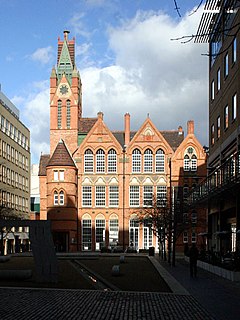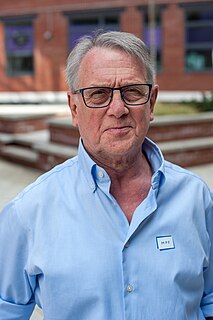Related Research Articles

Nottinghamshire is a county in the East Midlands region of England, bordering South Yorkshire to the north-west, Lincolnshire to the east, Leicestershire to the south, and Derbyshire to the west. The traditional county town is Nottingham, though the county council is based at County Hall in West Bridgford in the borough of Rushcliffe, at a site facing Nottingham over the River Trent.

The Ikon Gallery is an English gallery of contemporary art, located in Brindleyplace, Birmingham. It is housed in the Grade II listed, neo-gothic former Oozells Street Board School, designed by John Henry Chamberlain in 1877. The gallery's current director is Jonathan Watkins.

Arnolfini is an international arts centre and gallery in Bristol, England. It has a programme of contemporary art exhibitions, artist's performance, music and dance events, poetry and book readings, talks, lectures and cinema. There is also a specialist art bookshop and a café bar. Educational activities are undertaken and experimental digital media work supported by online resources. A number of festivals are regularly hosted by the gallery.
Dr Pogus Caesar is a British photographer, conceptual artist, archivist, author, curator, television producer and director. He was born in St Kitts, West Indies, and grew up in Birmingham, England.
Nicholas Bullen is an English composer, artist and writer.
Kira O'Reilly is a performance artist based in the UK. She graduated from Cardiff School of Art in 1998, and has participated in a number of performance art festivals throughout the UK and Europe, including at the Bonington Gallery, Nottingham Trent University 1998, the National Review of Live Art, in Glasgow, at Arnolfini in Bristol, at Home in London and at several European festivals including Break 21 Festival, Ljubljana, Slovenia, 2002 and ANTI - Contemporary Art Festival 2003, Kuopio, Finland. She performed in China at the Dadao performance art festival, Beijing, organised by Shu Yang 2006.
Richard Digby Day is a British stage director and international professor and lecturer. He is particularly well known for his work in the classical theatre, and is considered to have a special penchant for the plays of William Shakespeare and George Bernard Shaw. He is vice president of the Shaw Society, a Fellow of the Royal Society of Arts, and has staged more productions of Shaw's work than any other living director. His productions of Stephen Sondheim musicals have also been notable.
Carol Hoorn Fraser (1930–1991) was an American-born figurative artist who worked for thirty years in Nova Scotia, Canada.

David Prentice was an English artist and former art teacher. In 1964 he was one of the four founder members of Birmingham's Ikon Gallery.
Duggie Fields is a British artist who resides in Earls Court, London.
Paul Feiler was a German-born artist who was a prominent member of the St Ives School of art: he has pictures hanging in major art galleries across the world.

Rose Garrard is an installation, video and performance artist, sculptor, and author. Garrard's works have been exhibited at the Victoria and Albert Museum, the Tate Gallery, the British Council maintained Great Britain pavilion at the 1984 Venice Biennale, and national galleries in Austria and Canada.

Mike Stubbs is a curator/director and filmmaker based in the UK, currently, the Creative Producer at Doncaster Creates. For 11 years he was the Director/CEO of FACT, the Foundation for Art and Creative Technology, a leading arts organisation for the commissioning and presentation of new media art forms. He has been a key contributor to the development of culture and cultural policy in Liverpool, UK. Stubbs was jointly appointed in May 2007 by Liverpool John Moores University, where he is Professor of Art, Media and Curating.
The following is a timeline of the history of the city of Nottingham, England.
Druie Bowett (1924–1998) was an English artist, member of The Midland Group and Women's International Art Club, and Fellow of the Royal Society of Arts.
Michael Warren is an English artist, known for painting birds. He has designed several series of commemorative postage stamps and book jackets, as well as publishing books of his own work. His works have also featured on the cover of the RSPB's Birds magazine. He is a member of the Society of Wildlife Artists and the Artists for Nature Foundation.

New Art Exchange is a contemporary art gallery in Nottingham's Hyson Green neighborhood representing contexts of Black, Asian, and minority ethnic artists and communities. The organisation formed as a charity in 2003 from APNA Arts and EMACA, which educationalist and historian Len Garrison helped to establish.

John Myers is a British landscape and portrait photographer and painter. Between 1973 and 1981 he photographed mundane aspects of middle class life in the centre of England—black and white portraits of ordinary people and suburbia within walking distance of his home in Stourbridge.
Marie Yates is a British fine conceptual artist whose artwork centers on addressing female representation and sexual difference in media and society. She was mentored by John Latham and exhibited alongside The Artist Placement Group. She is best known for her landscape works combining installation, text and imagery.
Barbara Steveni was a British conceptual artist who was based in London. Steveni was the co-founder and director of the Artist Placement Group (APG), which ran from the 1960s to the 1990s. The APG's goal was to refocus art outside galleries and museums. It instead installed artists in industrial and government organizations to both learn about and to have a voice in these worlds and then, where possible, organize exhibitions of work related to those experiences. Its work was a key precursor of the now widely-applied artist in residency concept.
References
- ↑ H. Neate (2012) 'Provinciality and the Art World: The Midland Group 1961-1977', Social and Cultural Geography 13(3): p. 275
- ↑ Midland Group Archive, Nottinghamshire County Council (DDMA 1/16 [Administration])
- ↑ Midland Group Archive, Nottinghamshire County Council (DDMA 1/24/1-72 [Administration])
- ↑ Midland Group Archive, Nottinghamshire County Council (DDMA 6 [Education])
- ↑ Macdonald, Ian W.; Popple, Simon (15 November 2012). Digging the Seam: Popular Cultures of the 1984/5 Miners' Strike. Cambridge Scholars Publishing. ISBN 9781443843041 – via Google Books.